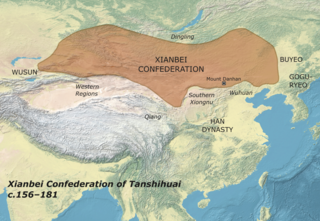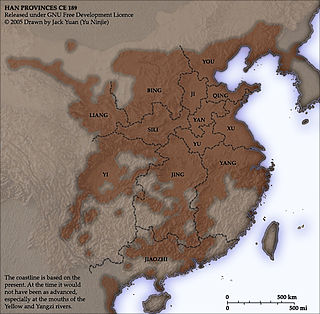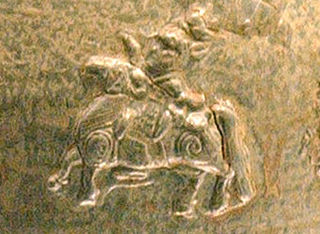The Five Barbarians,or Wu Hu,is a Chinese historical exonym for five ancient non-Han "Hu" peoples who immigrated to northern China in the Eastern Han dynasty,and then overthrew the Western Jin dynasty and established their own kingdoms in the 4th–5th centuries. The peoples categorized as the Five Barbarians were:

Wei,known in historiography as the Northern Wei,Tuoba Wei,Yuan Wei and Later Wei,was an imperial dynasty of China ruled by the Tuoba (Tabgach) clan of the Xianbei. The first of the Northern dynasties,it ruled northern China from 386 to 535 during the period of the Northern and Southern dynasties. Described as "part of an era of political turbulence and intense social and cultural change",the Northern Wei dynasty is particularly noted for unifying northern China in 439,bringing an end to the chaotic Sixteen Kingdoms period,and strengthening imperial control over the rural landscape via reforms in 485. This was also a period of introduced foreign ideas,such as Buddhism,which became firmly established. The Northern Wei was referred to as "Plaited Barbarians" by writers of the Southern dynasties,who considered themselves the true upholders of Chinese culture.

The Xianbei were an ancient nomadic people that once resided in the eastern Eurasian steppes in what is today Mongolia,Inner Mongolia,and Northeastern China. The Xianbei were strongly suggested to be a multilingual,multi-ethnic confederation consisting of mainly Proto-Mongols,and,to a minor degree,Tungusic and Turkic peoples. They originated from the Donghu people who splintered into the Wuhuan and Xianbei when they were defeated by the Xiongnu at the end of the third century BC. Following the split,the Xianbei people did not have a direct contact with the Han dynasty,residing to the north of the Wuhuan. In the first century BC,the Xianbei began to actively engage in the struggle between the Han and Xiongnu,which culminated in the Xianbei replacing the Xiongnu on the Mongolian Plateau in 93 AD.

Qin,known as the Former Qin and Fu Qin (苻秦) in historiography,was a dynastic state of China ruled by the Fu (Pu) clan of the Di peoples during the Sixteen Kingdoms period. Founded in the wake of the Later Zhao dynasty's collapse in 351,it completed the unification of northern China in 376 during the reign of Fu Jiān,being the only state of the Sixteen Kingdoms to achieve so. Its capital was Chang'an up to Fu Jiān's death in 385. The prefix "Former" is used to distinguish it from the Later Qin and Western Qin dynasties that were founded later.

Zhao,briefly known officially as Wei (衛) in 350 AD,known in historiography as the Later Zhao or Shi Zhao (石趙),was a dynasty of China ruled by the Shi family of Jie ethnicity during the Sixteen Kingdoms period. Among the Sixteen Kingdoms,the Later Zhao was the second in territorial size to the Former Qin dynasty that once unified northern China under Fu Jian. In historiography,it is given the prefix of "Later" to distinguish it with the Han-Zhao or Former Zhao,which changed its name from "Han" to "Zhao" just before the Later Zhao was founded.

Yan,known in historiography as the Former Yan,was a dynastic state of China ruled by the Murong clan of the Xianbei during the Sixteen Kingdoms period. From Liaoning,the Former Yan later conquered and ruled over Hebei,Shaanxi,Shandong and Henan at its peak. They were notably the first of several Xianbei states to have establish their rule over the Central Plains. The prefix of "Former" is used in historiography to distinguish them from the other Yan states that came after them such as Later Yan.
The Duan was a tribe of Xianbei ethnicity during the era of Sixteen Kingdoms in China. They were a powerful tribe in the Liaoxi region and played a key role during the fall of the Western Jin dynasty. Unlike the Xianbei tribes of the steppe,the Duan were unique in that they were established within the borders of China. They ruled over their dukedom of Liaoxi and later established the Duan Qi state,although neither were considered part of the Sixteen Kingdoms. The tribe was conquered by the Murong-led Former Yan in 338,but remained politically influential as maternal relatives of the Murong.
Ran Min,also known as Shi Min (石閔),posthumously honored by the Former Yan as Heavenly King Wudao of (Ran) Wei ( 魏武悼天王),courtesy name Yongzeng (永曾),nickname Jinu (棘奴),was a military leader during the era of Sixteen Kingdoms in China and the only emperor of the short-lived state Ran Wei (冉魏). He was known for ordering the culling of the Jie and other barbarians,during which 200,000 people,both Han and non-Han people,were killed between 349 and 350.
Murong Huang,courtesy name Yuanzhen (元真),also known by his posthumous name as the Emperor Wenming of Former Yan (前燕文明帝),was the founding monarch of the Xianbei-led Former Yan dynasty of China. When he first succeeded his father Murong Hui in 333,he carried the Eastern Jin-bestowed title Duke of Liaodong,but in 337 claimed the title of Prince of Yan,which is traditionally viewed as the founding date of Former Yan. After his son Murong Jun completely broke away from the Eastern Jin and claimed the title of emperor in January 353,he was posthumously elevated to imperial status. In the Book of Jin,Murong Huang was described as a strong looking tall man.
Murong Jun,Xianbei name Helaiba (賀賴跋),courtesy name Xuanying (宣英),also known by his posthumous name as the Emperor Jingzhao of Former Yan (前燕景昭帝),was the second and penultimate ruler of the Former Yan dynasty of China. He initially held the Eastern Jin-created title of Prince of Yan,but later claimed the title of emperor in 353. During his reign,the state expanded from possessing merely modern-day Liaoning and parts of Hebei to nearly all of the territory north of the Yellow River and some substantial holdings south of the Yellow River. The Book of Jin described Murong Jun as being approximately two metres tall and having an imposing look.
Murong Ke,courtesy name Xuangong (玄恭),formally Prince Huan of Taiyuan (太原桓王),was a famed general and statesman of the Xianbei-led Chinese Former Yan dynasty. He was a son of Murong Huang,and later served as the regent for his brother Murong Jun 's son Murong Wei.
Murong Ping,(before 339-after 372),was a regent of the Xianbei-led Former Yan dynasty of China during the reign of Murong Wei,after the death of the previous,far more capable regent Murong Ke. He,along with Murong Wei's mother Empress Dowager Kezuhun,is often blamed for the Former Yan's decline and fall.

You Prefecture or YouProvince,also known by its Chinese name Youzhou,was a prefecture (zhou) in northern China during its imperial era.

The Upheaval of the Five Barbarians also translated as the Uprising,Rebellion or the Revolt of the Five Barbarians is a Chinese expression used to refer to a chaotic period of warfare during the Jin dynasty (266–420) roughly between 304 and 316 which heavily involved non-Han peoples living in China,commonly called the Five Barbarians. Coinciding with the War of the Eight Princes that greatly weakened the empire,these conflicts eventually drove the Jin imperial court out of northern and southwestern China.
The Ran Wei–Later Zhao War,or Wei–Zhao War,was a conflict in northern China in 350 CE,during the chaotic Sixteen Kingdoms period. In 350,Ran Min proclaimed himself emperor of Wei amid the succession struggles of the Later Zhao dynasty. The Jie people,who founded the Later Zhao,did not accept Ran Min's rule and rose against him;they were joined by many other dynasties established by the Five Barbarians that also opposed Ran Min. The resulting war ended with a decisive victory for Ran Min.

Huan Wen's Northern Expeditions were a series of expeditions launched by the Eastern Jin general Huan Wen and aimed at attempting to reclaim Jin's territory north of the Huai River. Due to the lack of support from the Jin court,the expeditions were unsuccessful.

The Jin dynasty was a major Chinese imperial dynasty. Following the devastation of the Three Kingdoms period,the Jin unified those territories and fostered a brief period of prosperity between 280 and 304 CE. However,during this period many social problems developed as well,the most pressing of which was the migration of non-Han tribes into Jin territory,to the point where they outnumbered the Han people in some regions.
The Sixteen Kingdoms,less commonly the Sixteen States,was a chaotic period in Chinese history from AD 304 to 439 when northern China fragmented into a series of short-lived dynastic states. The majority of these states were founded by the "Five Barbarians",non-Han peoples who had settled in northern and western China during the preceding centuries,and had launched a series of rebellions against the Western Jin dynasty in the early 4th century. However,several of the states were founded by the Han people,and all of the states—whether ruled by Xiongnu,Xianbei,Di,Jie,Qiang,Han,or others—took on Han-style dynastic names. The states frequently fought against both one another and the Eastern Jin dynasty,which succeeded the Western Jin in 317 and ruled southern China. The period ended with the unification of northern China in 439 by the Northern Wei,a dynasty established by the Xianbei Tuoba clan. This occurred 19 years after the Eastern Jin collapsed in 420,and was replaced by the Liu Song dynasty. Following the unification of the north by Northern Wei,the Northern and Southern dynasties era of Chinese history began.

The military history of the Jin dynasty and the Sixteen Kingdoms encompasses the period of Chinese military activities from 266 AD to 420 AD. The Jin dynasty is usually divided into the Western Jin and Eastern Jin in Chinese historiography. Western Jin lasted from its usurpation of Cao Wei in 266 to 316 when the Uprising of the Five Barbarians split the empire and created a number of barbarian states in the north. The Jin court relocated to Jiankang,starting the era of Eastern Jin,which ended in 420 when it was usurped by Liu Yu,who founded the Liu Song dynasty.

Wei,known as Ran Wei (冉魏) in Chinese historiography,was a short-lived dynastic state of China established by Ran Min. In 350,Ran Wei usurped the throne of the Later Zhao dynasty in the city of Ye and declared himself Emperor of Wei. In 352,Ran Wei was defeated by the Former Yan dynasty.









